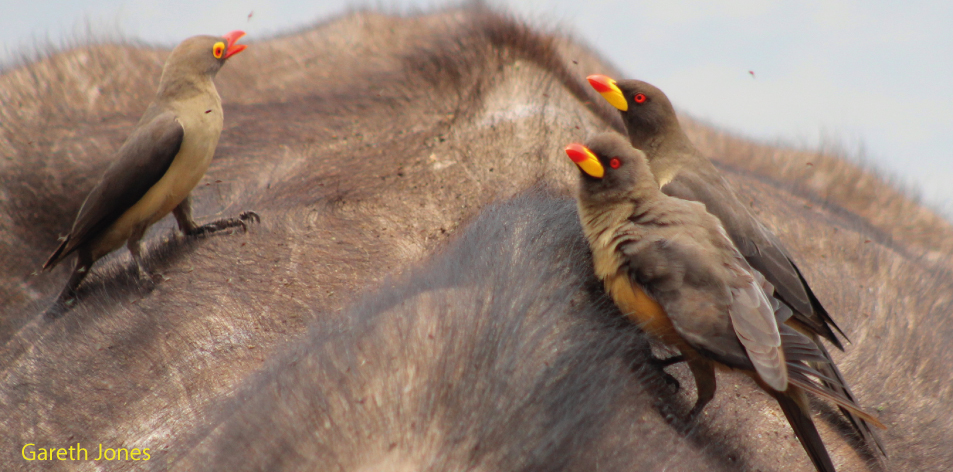
Interesting Symbiotic Relationships!!- Article by Gareth Jones
Interesting Symbiotic Relationships In The Nairobi National Park
We observed a large herd of buffalo drinking water and wallowing at the Embakasi dam, however, we were fascinated by the presence of many red-billed and yellow-billed oxpeckers on and around the buffalo herd. As we sat quietly the oxpeckers moved all over the buffalo bodies looking for delicious parasitic snacks like ticks and lice.
Ticks (suborder Ixodida) are parasitic arachnids that are part of the superorder Parasitiformes. Along with mites, they constitute the subclass Acar I. Ticks are therefore not actually insects and are more closely related to spiders as they also have eight legs. Ticks are major disease-carrying pests particularly in many parts of Africa. There are two main groups of ticks, namely the Ixodidae or hard ticks, and the Argasidae, or soft ticks.
Interestingly there are about 900 different types of ticks in nature .. Ticks are external parasites, living by hematophagy on the blood of mammals, birds, and sometimes reptiles and amphibians. Ticks carry a number of diseases, including African tick bite fever, tick-borne relapsing fever, babesiosis, and tick paralysis.
Microbiological pathogens can cause serious disease especially in a weakened host and can even result in death. One recorded case is the death of the famous lioness “Elsa”, who died in the Meru National Park after fighting with other lions, and then having a weakening immunity became infected with tick bite fever due to not having resistance to the babesia Leo parasite.
Another somewhat indirect relationship involves guineafowl and their role in the reduction of ticks. It can even be said that Guineafowl is one of the best friends that lions could ever have, even though all lions are completely unaware of the benefit they have from the actions of guineafowl. The guineafowl eats thousands of ticks that are not on animals, by continuously searching and scratching on the ground. Next time you see guineafowl, you will hopefully appreciate them more due to their special role in pest reduction, and improving the health of species like lions.
A close ecological relationship involving two or more species that can benefit all parties is known as symbiotic mutualism. It can also benefit one party without affecting the others this is called commensalism or help one while harming the others called parasitism. The relationship between the buffalo and the tickbird hovers somewhere between mutualism and parasitism because the tickbirds seem to derive greater benefit from the relationship than the buffalo.
Red-billed & yellow-billed oxpeckers have long been thought to remove ticks from their hosts to the benefit of both—the bird eats the ticks, and the host is relieved of blood-sucking, disease-carrying parasites, however, oxpeckers can also aggressively bore into wounds on animals to access blood. A secondary benefit to a host from the tickbird’s presence is a sort of early warning system since the birds make a hissing sound if they sight an enemy. This is of less benefit to the buffalo than to other hosts if the buffalo are in a large protective herd.
Another example of mutualism is the relationship between crocodiles and Egyptian plovers, the crocodile leaves its mouth open while basking on the shore, and the bird walks in and picks bits of rotting flesh from between the croc’s teeth; the plover gets food and the croc gets a cleaner mouth. The determining factor of mutualism is consent: the crocodile does not have to open its mouth for the bird but chooses to do so. Crocodiles appear to know that the birds benefit from the oral hygiene inside their mouths.
So next time you are in the park, be on the lookout for species that have interesting natural symbiotic relationships. If possible, find a large herd of buffalo and then sit quietly as you watch the pests being removed by the peckers.


